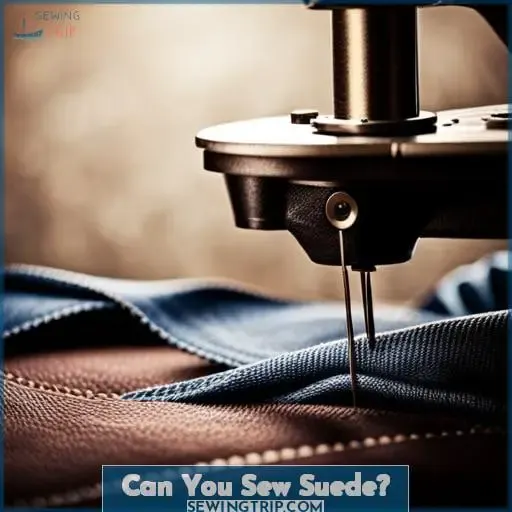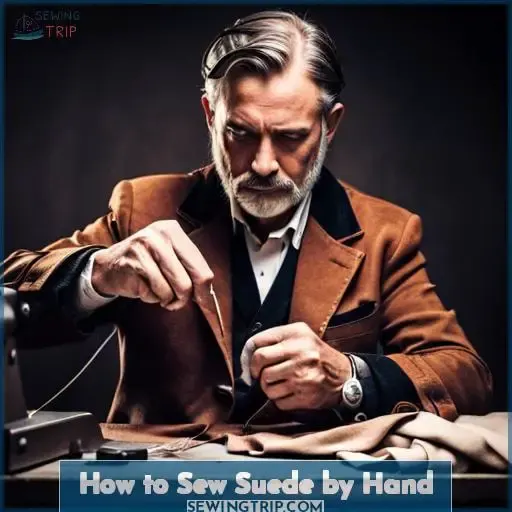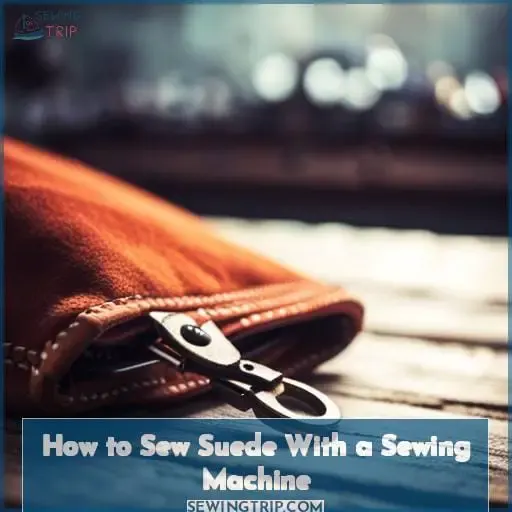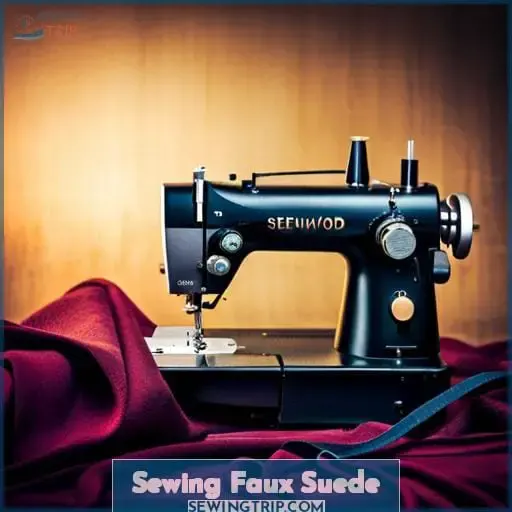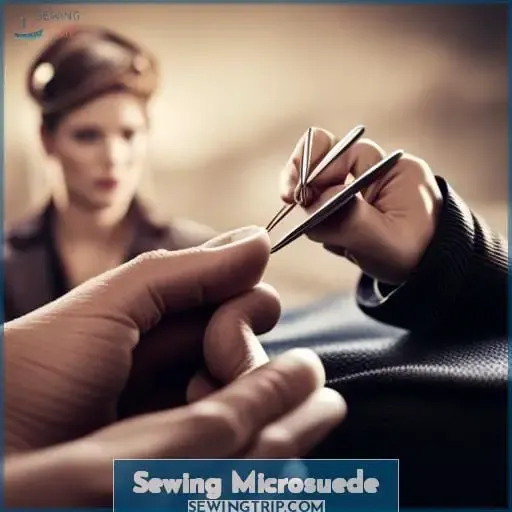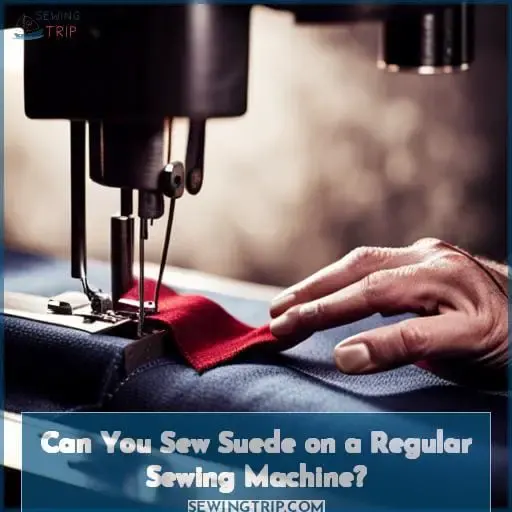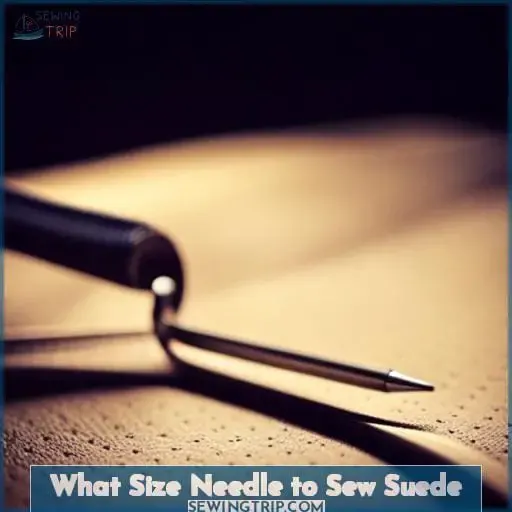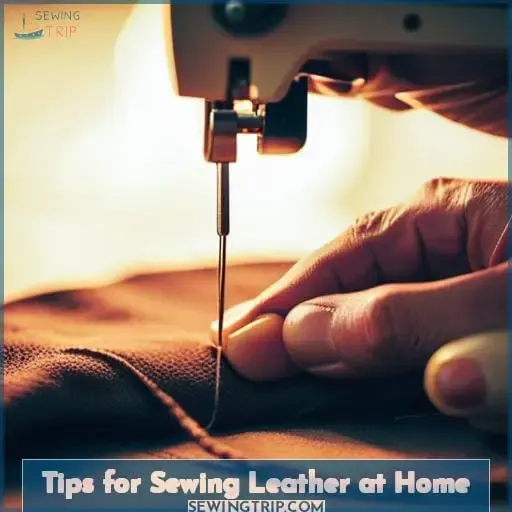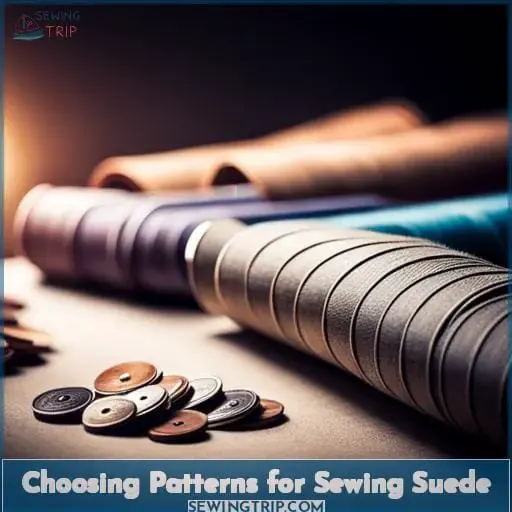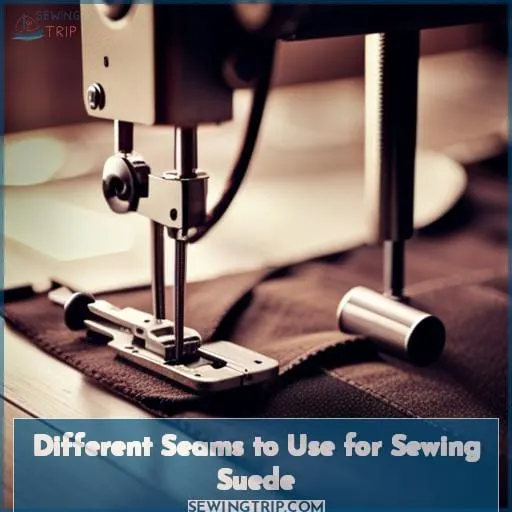This site is supported by our readers. We may earn a commission, at no cost to you, if you purchase through links.
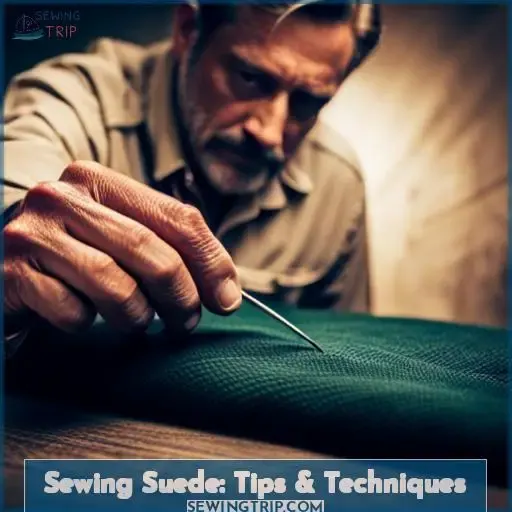 Get ready to master the art of sewing suede with these helpful tips and techniques! Whether you’re a beginner or an experienced sewer, this article will guide you through sewing faux suede, microsuede, and even real leather.
Get ready to master the art of sewing suede with these helpful tips and techniques! Whether you’re a beginner or an experienced sewer, this article will guide you through sewing faux suede, microsuede, and even real leather.
Discover how to sew by hand or with a machine, choose the right needle size for your project, and explore different seam options.
Table Of Contents
- Key Takeaways
- Can You Sew Suede?
- How to Sew Suede by Hand
- How to Sew Suede With a Sewing Machine
- Sewing Faux Suede
- Sewing Microsuede
- Can You Sew Suede on a Regular Sewing Machine?
- What Size Needle to Sew Suede
- Tips for Sewing Leather at Home
- Choosing Patterns for Sewing Suede
- Different Seams to Use for Sewing Suede
- Frequently Asked Questions (FAQs)
- Conclusion
Key Takeaways
- Use a leather needle (size 14-18) and heavy-duty thread
- Cut with the nap and use steam to maintain pliability
- Avoid pins, use pattern weights or wonder clips
- Topstitch seams on either side for added strength
Can You Sew Suede?
Yes, you can sew suede using both hand sewing and a sewing machine.
Suede, known for its luxurious feel and texture, offers a versatile canvas for your stitching endeavors. When it comes to sewing suede, precision is key. Ensure you have the right tools—a leather point needle and heavy-duty thread—to navigate its unique characteristics.
Careful cutting is vital; maintain the consistency of your pattern pieces by cutting with the nap. This not only preserves the fabric’s style but also contributes to suede’s durability.
Styling suede involves understanding its finishes and maintenance. Whether it’s genuine suede or faux, caring for it remains crucial. Avoid pinning suede directly to prevent marks, opting instead for pattern weights.
Seam care and pressing techniques play pivotal roles in maintaining the fabric’s integrity. Hand sewing suede offers a therapeutic touch, allowing for precise control over every stitch, while machine sewing demands a slow, cautious approach due to the fabric’s expense and delicacy.
Ultimately, sewing suede is a skill that rewards attention to detail and practice. Embrace this material’s elegance and resilience, and with the right techniques, you can master the art of sewing suede, whether by hand or with a sewing machine.
How to Sew Suede by Hand
Transitioning from the inquiry of hand-sewing suede, dive into the craftsmanship of this tactile artistry. Mastering hand-sewing suede imbues your creations with bespoke allure and artisanal finesse.
- Choose Your Stitching Style: Embrace the beauty of saddle stitching, employing double-handed precision for durable seams that exude craftsmanship.
- Craft Handcrafted Details: Elevate your pieces with unique embellishments, using contrasting threads or customized embroidery for personalized touches.
- Master the Art of Hand Sewing: Harness the tactile nature of suede, allowing your fingertips to guide each stitch with care and control.
- Perfect Your Artisanal Finishes: Seamlessly blend and knot your threads for a flawless finish, ensuring every detail exudes bespoke excellence.
Sewing suede by hand is an art form that offers both challenge and fulfillment. Each stitch intertwines craftsmanship and control, granting you mastery over the material’s nuances. Embrace this tactile journey as you craft with precision and finesse, transforming suede fabric into bespoke creations that reflect your artistry and dedication.
How to Sew Suede With a Sewing Machine
First, when sewing suede with a machine, ensure you have the right equipment and a slow, deliberate approach for optimal results.
- Use Specialized Machine Feet: Employ edge stitch or blind stitch feet for precise stitching and control over seam allowances.
- Go Slow and Exercise Caution: Due to suede’s delicate nature and expense, take your time while sewing to prevent mistakes and ensure accuracy in stitching.
- Optimize Stitch Length: For topstitching on suede, use longer stitch lengths to maintain the material’s integrity while creating clean, visible seams.
Sewing suede with a machine demands a mindful and careful approach. Utilize specialized feet to enhance precision and control over stitching. Going slow is key; rushing can lead to errors or damage to the material. Additionally, adjusting stitch lengths ensures the seams are secure without compromising the suede’s softness.
By incorporating these techniques, you can navigate the challenges of working with suede on a machine, ensuring your creations reflect the craftsmanship and attention to detail you desire.
Sewing Faux Suede
When sewing faux suede, you can enhance the fabric’s performance by considering its weight and using fusible interfacing for lining.
Faux suede, also known as synthetic suede or faux leather, offers a great alternative to genuine suede with its durability and affordability.
To reduce bulk when sewing faux suede, trim seam allowances after topstitching for softer seams that are easier to turn.
Soften seams further by trimming topstitched seam allowances down to 1/8 inch while keeping other seams at 1/4 inch.
To achieve stitching finesse with faux suede, use standard needles in sizes 9-11 and adjust the tension on your machine to prevent thread pulling. It’s also recommended to pre-wash the fabric with fabric softener before starting your project.
Pattern adaptation is essential when working with any type of material, including faux suedes. Consider pattern placement carefully so that it follows the nap of the fabric consistently throughout your garment or accessory.
For creative embellishments on your projects made from fake suedes such as jackets or bags consider adding contrast stitching details using heavy-duty threads in coordinating colors which will add visual interest and reinforce seam strength.
Remember these tips while you sew your next project!
Sewing Microsuede
To sew microsuede, gather the appropriate needles and thread for this fabric type.
Microsuede is a synthetic suede that has similar characteristics to real suede but is easier to work with.
Here are some tips and techniques for sewing microsuede:
-
Seam Finishing:
Since microsuede doesn’t fray like other fabrics, you can choose from various seam finishes depending on your preference and the desired look of your project.
Options include serging the seams, using pinking shears to trim excess fabric, or simply leaving the edges raw.
-
Hemming Techniques:
When hemming microsuede, it’s best to use a double-folded hem or a blind stitch hem for a clean finish that won’t show on the right side of the fabric.
-
Seam Reinforcement:
To reinforce seams in microsuede projects that may experience stress or heavy usage, consider using an additional layer of interfacing along with topstitching over each seam line.
Remember these key points when working with microsude:
- Use appropriate needles (microtex or ballpoint) designed specifically for synthetic fabrics.
- Consider pre-washing your fabric before sewing as it may shrink slightly.
- Opt for polyester thread which will provide strength and durability when working with this type of material.
By following these tips and techniques when sewing micrsosude,you’ll be able to achieve professional-looking results while enjoying all its benefits such as softness,durability,and versatility in different typesof projects
Can You Sew Suede on a Regular Sewing Machine?
Certainly! With the right techniques and tools, you can effectively sew suede on a regular sewing machine without much difficulty. While suede can pose challenges due to its delicate nature, following specific methods ensures successful sewing.
| Suede Machine Compatibility | Stitching Challenges | Seam Reinforcement |
|---|---|---|
| Ensure your machine can handle thicker materials; use a leather point needle (size 14-18) and heavy-duty thread. | Adjust tension and test stitches on scrap suede to tackle potential puckering or thread pulling. | Topstitch seams on either side for added strength; trim excess seam allowance after for softer seams. |
When working with suede, managing the material is crucial:
- Suede Finishing: Employ longer stitch lengths and specialized feet like an Edgestitch foot for precise results.
- Material Handling: Cut with the nap and use steam to maintain pliability, brushing the nap if crushed.
- Hemming Techniques: Avoid pins to prevent scarring; utilize pattern weights and go slow to ensure accuracy.
Navigating the challenges of suede on a regular machine involves mastering specific techniques, like adjusting tension and selecting appropriate needles and thread. By reinforcing seams and handling suede delicately, your sewing projects with this luxurious material will yield professional results.
What Size Needle to Sew Suede
You’ll need a larger needle size, typically around 14 to effectively sew suede.
This size ensures the needle can smoothly penetrate the material without causing undue stress or damage.
Opting for a larger gauge prevents the needle from leaving visible holes, maintaining the suede’s integrity while providing a strong foundation for your stitches.
When dealing with suede, the needle’s thickness is key. The material’s softness requires a gentle touch but also demands a needle sturdy enough to handle it. A size 14 needle strikes that balance, allowing you to stitch through suede without compromising its texture or structure.
For those delving into stitching suede at home, acquiring the right tools is crucial. Investing in leather point needles and heavy-duty thread specifically designed for leatherwork will enhance your sewing experience.
These tools, coupled with the appropriate needle size, ensure smooth stitching and durable seams, particularly important when working with a material as distinctive as suede.
Mastering the art of stitching suede involves understanding the importance of needle gauge and thickness. With a size 14 needle, you can confidently embark on your suede sewing journey, equipped with the tools and knowledge necessary for seamless stitching and impeccable results.
Tips for Sewing Leather at Home
At home, you can achieve excellent results when sewing leather by applying consistent pressure and using specialized tools for precision.
- Use a Leather Needle:
When sewing leather on a home sewing machine, it’s important to use the right needle. A leather needle (size 14-18 gauge) is designed specifically for piercing through tough materials like suede or faux leather.
- Consider Your Sewing Machine:
Before starting your project, make sure your home sewing machine is suitable for stitching heavy-duty fabrics like suede. Some machines may struggle with the thickness of the material or lack certain features needed for effective stitching.
- Stitch Innovations:
To create durable seams in your suede projects, consider using innovative stitching techniques such as lapped seams, welt seams,and flat felled seams that provide extra strength and reduce bulkiness.
4.Seam Finishes and Hemming Techniques :
Since raw edges of suede tend to fray easily,it’s important to finish off seam allowances properly.Use seam finishes such as pinked edges,bound seems ,and hemming techniques like turning up fabric under itself before topstitching,to give clean finished look while enhancing durability of garment.Also remember notches should also be overcasted so they don’t get lost after repeated washing.
Choosing Patterns for Sewing Suede
When selecting patterns for sewing suede, prioritize alignment techniques to ensure consistency in the material’s direction. Consider the pressing methods crucial for suede to maintain its pliability and shape post-stitching.
Additionally, focus on needle choices and topstitching tips to reinforce seams effectively for durable suede projects.
Pattern alignment techniques
To ensure precision in sewing suede, align your pattern pieces thoughtfully and strategically, maintaining consistency in their orientation for optimal results.
Prioritize pattern matching and seam alignment while optimizing layout for efficient cutting.
Preserve material integrity by avoiding tight squeezes and laying pattern pieces facing down along the material’s length.
This meticulous approach ensures not just precision but also a smoother, more controlled sewing experience.
Seam pressing methods
Ensure an optimal seam finish for suede garments by employing steam to press seams open effectively and aid in making the material more pliable.
Precision pressing with steam allows for edge control, reinforcing seams while maintaining surface treatment.
Seam finishing becomes essential for suede, ensuring reinforced edges without compromising the material’s integrity.
This technique enhances control, a crucial aspect when handling delicate suede fabrics in garment construction.
Needle and topstitching tips
Optimize your suede sewing experience by carefully selecting the right needle and mastering topstitching techniques.
- Choose a larger needle size, such as 14, for suede, enhancing stitch precision.
- Employ an Edgestitch foot for clean topstitching lines.
- Utilize steam techniques to make suede more pliable, aiding in smooth topstitching.
- Consider thread choices carefully, opting for heavy-duty options.
Mastery of these needle and topstitching tips ensures your suede projects exhibit both durability and a professional finish.
Different Seams to Use for Sewing Suede
After choosing patterns for sewing suede, you’ll need to decide on the best seams to use.
The type of seam you choose will depend on your desired look and the thickness of your suede fabric.
Here are a few different seams that work well with suede:
-
Flat Fell Seam:
This seam is commonly used in denim jeans and creates a durable finish. It involves folding one edge of the fabric over another and stitching it down.
-
Lapped Seam:
A lapped seam is created by overlapping two pieces of fabric and sewing them together along one side. This type of seam provides strength while keeping bulk to a minimum.
-
French Seam:
If you’re looking for a clean finish without any raw edges showing, consider using a French seam. It involves enclosing raw edges within multiple layers of stitching.
These are just some examples; there are many other types depending on your project’s requirements or personal preference, such as mock flat fell or serged seams. Experimenting with these different techniques can help elevate your skills in working with suede while giving you more control over achieving professional-looking results.
Frequently Asked Questions (FAQs)
What are the best needles for sewing suede?
For sewing suede, use a sharp leather point needle (size 14-18 gauge) and heavy-duty thread.
Can you sew suede with a regular sewing machine?
You bet! Just use a roller presser foot, leather needle, and polyester/nylon thread for best results.
What are the best ways to hold suede fabric in place while sewing?
To hold suede fabric in place while sewing, use:
- Pattern weights
- Silk pins
- Wonder clips
Avoid using pins as they can leave holes in the fabric.
How do you prevent suede from puckering when sewing?
To prevent suede from puckering, keep the fabric taut as you sew and use a roller presser foot or Teflon foot on your sewing machine.
What are the best ways to finish seams in suede?
To finish seams in suede, use a roller presser foot, leather needle, and polyester/nylon thread for thickness.
Adjust stitch length and modify sewing habits for regular machines.
Conclusion
Sewing suede is a great way to add a touch of luxury to your wardrobe. With these expert tips, you’ll be able to sew suede like a pro in no time!
Choose the right needle.
A sharp, fine needle is essential for sewing suede. A ballpoint needle will damage the fabric, so be sure to use a sharp needle designed for sewing leather or suede.
Use a light touch.
Suede is a delicate fabric, so be sure to use a light touch when sewing. Pressing too hard can damage the fabric and make it difficult to sew.
Use a walking foot.
A walking foot is a special type of sewing foot that helps to feed the fabric evenly through the machine. This is especially important when sewing suede, as it can be difficult to keep the fabric from bunching up.
Pre-treat the fabric.
Pre-treating the fabric with a suede protector can help to prevent the fabric from fraying or shedding. This is especially important if you plan on wearing the garment frequently.
Use a seam ripper.
A seam ripper is a handy tool for making repairs or alterations to suede garments. It can also be used to remove stitches if you make a mistake.
Be patient.
Sewing suede can be a bit tricky, but it’s definitely doable with a little patience.

